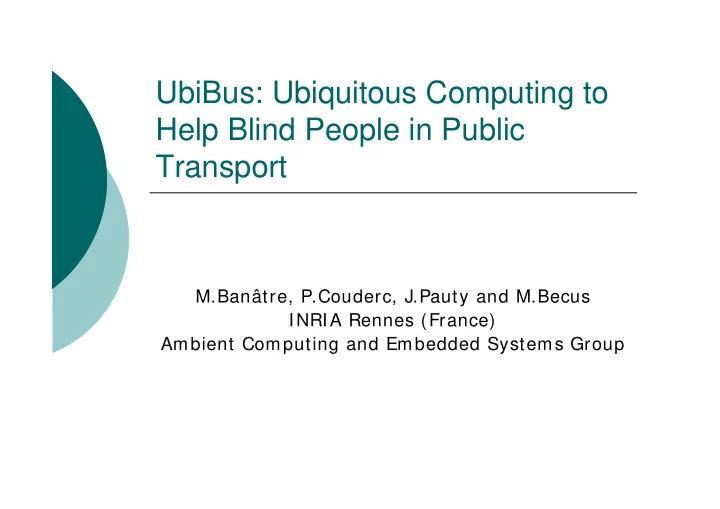

UbiBus: Ubiquitous Computing to Help Blind People in Public Transport M.Banâtre, P.Couderc, J.Pauty and M.Becus INRIA Rennes (France) Ambient Computing and Embedded Systems Group
Goal Ubiquitous computing to provide “spontaneous” � services � Spontaneous : � Explicit interactions between the user and the computers are reduced at the minimum level � The service is driven automatically by the events of the real world � Motivations � Improving existing service operation without being intrusive for the user � Improving the usability of information systems in the context of mobile devices (ex: the mobile device reflects the close environment) � � Overcom ing people disabilities by : Providing context triggered help and assistance to the user � Making the environment and the services aware of the presence � of disables people
Idea A programming model which promotes the design of � spontaneous operation for the application How? � � By providing programming abstractions directly related to interactions between physical objects. Benefits: � � The program is structured around physical objects and their interactions � Programming is simple because � You don't have to determined what is the context, and then take the appropriate actions: � You just have to "attach" code to already existing interactions (in the real world), reflected in the system
Spatial programming / SPREAD � Abstractions: � Physical objects = data symbol (tuple) � Physical mobility = data flow � Physical space = associative memory � Tuple-space � Association/ matching based on � Data properties � Geometrical properties: the data reside inside a Shape around the object which publishes the tuple � Synchronization: like a "token-machine", where "tokens" are represented by physical objects. An action need a set of tokens to be proceeded. � Implementation � A “wireless P2P” architecture, relying only on autonomous nodes.
Example � Stopping the bus in Ubi Bus… Token: < U-STOP, Bus# 16> rd < U-STOP, ‘Bus# 16’> out < S-STOP, ‘Bus# 16’> rd < S-STOP, ‘Bus# 16’> Notify driver !
Conclusion � A “natural way” to reduce explicit interactions : � Directly controlling the application with physical objects � Not only at the user level… � … But also at the programming level � UbiBus: � An effective application of this concept � Demonstrated to potential users, encouraging first impressions, especially the simplicity � The user terminal was a problem
Recommend
More recommend